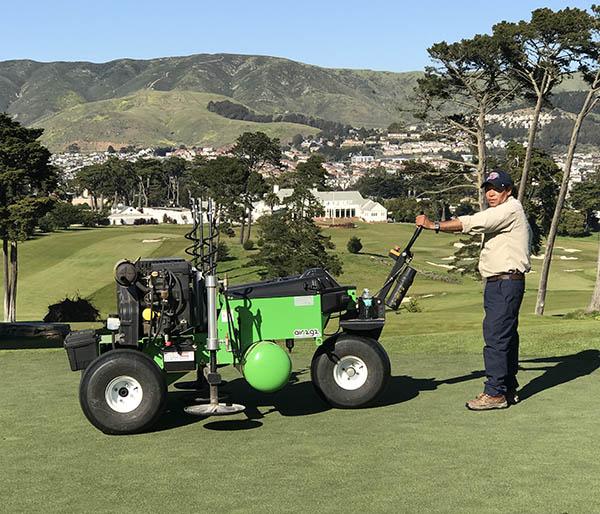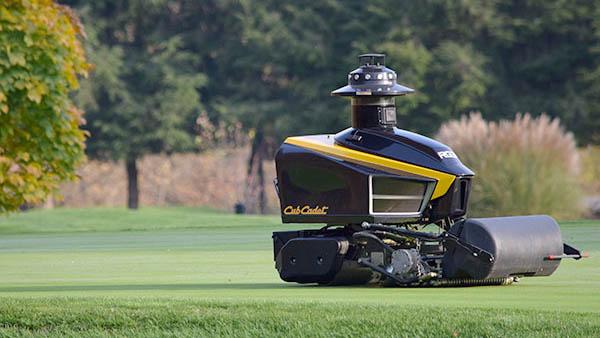Life as an early adopter of new technology often means walking a fine line between being a cutting-edge turf manager and someone perceived as a someone who just likes the latest gadgets.
 Thomas Bastis, CGCS, is one of those early adopters. Every time some company comes up with a new way to help him maximize resources and playing conditions at the California Golf Club of San Francisco, he tries to be cognizant of how the latest technology will be perceived by members. Some of the things he's used on the golf course, including multiple drones outfitted with a GoPro and an Air2G2 compressed-air aerifier, he has bought with his own money because, while nice to have, they are not essential for day-to-day maintenance.
Thomas Bastis, CGCS, is one of those early adopters. Every time some company comes up with a new way to help him maximize resources and playing conditions at the California Golf Club of San Francisco, he tries to be cognizant of how the latest technology will be perceived by members. Some of the things he's used on the golf course, including multiple drones outfitted with a GoPro and an Air2G2 compressed-air aerifier, he has bought with his own money because, while nice to have, they are not essential for day-to-day maintenance."I have to be careful what I ask the club for," Bastis said. " Is this something he needs, or is this just another toy for Thomas? All he wants are gadgets and gizmos.' I get that a lot."
The latest tech tools soon to make their way to the Cal Club are no toys, and the way they will help Bastis better utilize his resources is not a game.
In June, he will acquire a pair of RG3 robotic greensmowers from Cub Cadet. He has been intrigued by the technology since it was launched about seven years ago by Precise Path, and even attended demo events in Florida and San Diego. But it wasn't until Precise Path was acquired by Cub Cadet's parent company, MTD Products, in 2015 that he started to give it serious consideration.
"I always knew what it was capable of doing," he said. "For me, it was more about the company than the product. Now I know I'm not going to get stuck with these things"
Convincing dues-paying members of the benefits of such technology is a bit more challenging, especially since the pervasive trickle down of a slow golf economy. To get buy in Bastis had to prove the RG3 could do much more than just mow in a straight line every time.
As the saying goes, money talks, and with the cost of labor on the rise in California where minimum wage is rising and is expected to hit $15 per hour in the next few years - a 33 percent jump compared with last year - the economics of golf is an increasingly easy case to make.
"Members can smell that change is coming, but they're not close enough to it to know what to make of it," Bastis said. "The cost of labor is going up, and the days of adding more staff in the future are gone. We have to prepare ourselves with technology. We have to find ways to make the staff we have now more effective.
The turns it takes are the types turns I want my guys to make. It's not whipping it around and getting done as fast as possible."
"The hard part about technology is proving to people that these things work. There is a lot of trust that you have a superintendent who can handle this. This is not a drone. They want to know what the return is on their investment and where are we going as a club."
The answer to that question, Bastis says, is toward greater overall efficiency.
The RG3 mows consistent lines and boundaries thanks to a system of beacons and underground wires that that create the equivalent of an invisible fence. It also does the jobs of several workers, Bastis says.
His crew is organized into groups of four members each, with each group assigned a different part of the golf course, and each member of each group assigned a specific set of tasks. One blows and mows greens and rakes bunkers, another rolls greens, another changes cups and another carries a TDR meter and is responsible for hand-watering.
Although the RG3 still needs a chaperone on every green, the idea, Bastis says, is that it eventually will allow him to economize labor.
"What I'm trying to do is eliminate two of them," he said.
"I can reassign them to do other things. That, to me, is going to pay for itself."
For Bastis, the RG3 is more than an acceptable replacement for an operator manning a walk mower. Although it is slower than a human operator, it mows in straight lines all the time, and more importantly, is better on turns, he said.
"The turns it takes are the types turns I want my guys to make. It's not whipping it around and getting done as fast as possible," he said.
"I don't mind that it mows slower. We need that time for the guy who is with it to finish what he is doing."
As with any new technology, the $64,000 question is how relevant will it be in the future.
"There is an economics in the game of golf that rears its head," Bastis said.
"This is a slippery slope. Where are we going to be with this stuff in 10 years? The hope is 10 to 15 years from now that we are less five laborers. Maybe we have one or two more mechanics, and maybe one of them will need an engineering degree."


